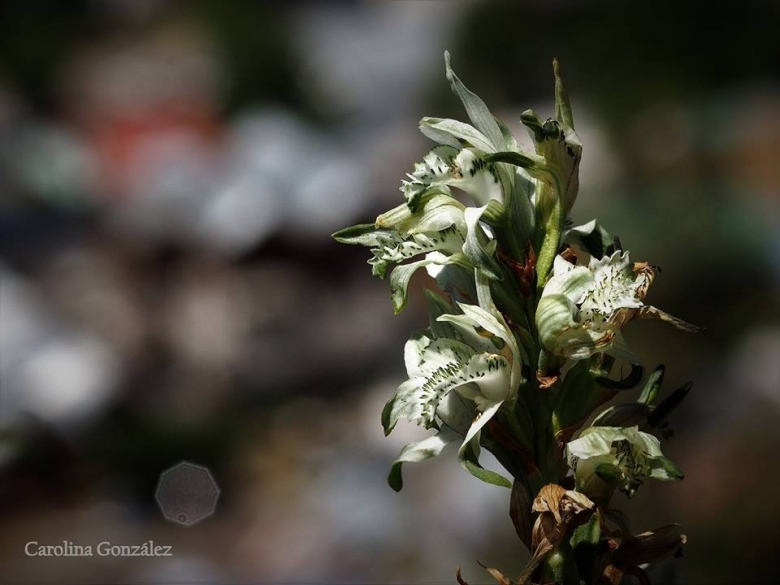= Chloraea virescens (Willd.) Lindl.
Quart. J. Sci. Lit. Arts n.s., 1: 51 (1827).
Accepted Scientific Name: Chloraea piquichen (Lamarck) Lindl.
Gen. Sp. Orchid. Pl. 400 (1840). Lindl.

Cymbidium virescens (Chloraea virescens) Photo by: Carolina González
Origin and Habitat: Chloraea virescensSN|34832]]SN|34834]] (Chloraea piquichenSN|34834]]SN|34832]]) occurs in southern Chile and Argentina.
Habitat and ecology: This species commonly grows on sandy or stony slopes of the Cordilleras of Chile and Argentina and flowers from (October-)November to January(-February). In Chile it grows in pastures, embankments and forests from Concepción to the Región of Los Lagos, preferably in the Biobío Region in sandy sites both on the coast and subalpine valley, it tends to form large populations. In Argentina it grows from San Martín to the Andes to the Nahuel Huapi National Park.
Synonyms:
See all synonyms of Chloraea piquichen
back
Accepted name in llifle Database:Chloraea piquichen (Lamarck) Lindl.Gen. Sp. Orchid. Pl. 400 (1840).Synonymy: 18
back
Common Names include:
SPANISH (Español): Piquichen
Description: Chloraea virescensSN|34834]]SN|34834]] (Chloraea piquichenSN|34832]]SN|34832]]) is a beautiful terrestrial Orchid, that bears a fine spike of large yellowidh-white flowers, handsomely veined with green. There are also some green tubercles at the base of the petals, and a green thickened part at the tip of the lateral sepals. Stems grow up to 40-90 cm high with lance-shaped leaves in a basal rosette, which are withered at anthesis.
Leaves: 5-12 cm long,1.5-2.5cm wide, narrow, lanceolate, sharp, arranged
in basal rosette, usually withered at the end of the anthesis. Leaves of the floral scape lanceolate, sharp.
Inflorescence: A dense erect spike 40-90(-100) cm tall, (10-)15-20 flowered.
*Flowers: Subtended by a membranous bracts with a thin tip, as long as the length of the ovariy. Sepals are white with prominent green stripes and sometimes with fleshy green theeth, dorsal sepal somewhat concave, sometimes slightly narrowed to the center 16-33mm long, 4-6mm wide; lateral sepals 18-33 mm long, 4-5mm wide, ensiform with obtuse apex, thickened, blackish green, sometimes, spatulate and dentate, sometimes warty. Lateral petals of the same colour as the sepals 15-23(35) mm long, 4-5.8 mm wide, oblong-lanceolate, linear, hanging, slightly contoured obtuse to somewhat acute, apex somewhat fleshy,with papillae on the nerves. The flower is dominated by a broadly oblong, more or less rhomboidal, denticulate, scarcely trilobed labellum (lip) 15-26mm long by 10-20mm wide, with three round lobes, the intermediate of which jagged. The labellum bears falcate processes along the veins, each one white tipped with green. The central lobe is crossed lengthwise by 5-7 lamellae (thin membranoussheets) and cylindrical hooked papillae, 2-3 mm long. Column (Gynostemium) half as long as the dorsal sepal, 12-18mm long,
thin, white, maculate with orange or reddish-brown lines towards the base. The wing of the column is straight and narrow. The stigma is triangular and globose. The base of the nectariferous zone is lemon-yellow with orange dots, the nectary hole is green.
Taxonomy: Chloraea piquichenSN|34832]]SN|34832]] (Lam.) Lindl. is the correct combination for Chloraea virescensSN|34834]]SN|34834]] Lindl, whose basionym is Limodorum piquichenSN|34833]]SN|34833]].
Bibliography: Major references and further lectures
1) Patricio Novoa, Jaime Espejo, Diego Alarcon, Mauricio Cisternas, Erwin Domínguez. “Guía de Campo de las Orquídeas Chilenas”, Segunda Edición Ampliada, pp 116-117 web: http://www.corma.cl/_file/material/guia-de-campo-orquideas-2015-web.pdf
2) Chloraea virescens in: “The New Plantsman” Royal Horticultural Society, 1996
3) Chloraea virescens in: “The Orchid Review”, Volume 34 Orchid Review Limited, 1926
4) VALÉRIE VAN GINDERDEUREN RAVESCHOT 2009 “Aclimatación de plántulas de Chloraea virescens (Willd.) Lindl. cultivadas in vitro.” Memoria presentada como parte de los requisitos para optar al título de Ingeniero Agrónomo. Web: http://cybertesis.uach.cl/tesis/uach/2009/fag492a/doc/fag492a.pdf








